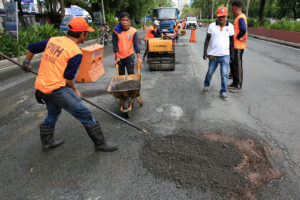By Aubrey Rose A. Inosante, Reporter
STATE INFRASTRUCTURE spending in October inched up by 2.52% annually, the Department of Budget and Management (DBM) said.
In the latest disbursement report, the DBM said spending on infrastructure and other capital outlays was “nearly flat” at P110 billion in October from P107.3 billion last year.
The DBM said the Department of Public Works and Highways (DPWH) had posted higher expenditures for its road and bridge network infrastructure projects in October.
However, this was offset by lower disbursements by the Department of Transportation (DoTr) and the Department of National Defense (DND), “due to the different timing of releases or schedule of payables for their big-ticket capital outlay items.”
“These, in turn, weighed down the growth of infrastructure spending for October 2024,” the DBM said.
Data from the DBM showed infrastructure spending rose by 13.22% to P1.09 trillion in the January-to-October period from P964.9 billion in the same period in 2023.
The DBM said the “robust” spending performance for this year was due to road infrastructure and defense projects, as well as “direct payments made by creditors to suppliers/contractors in connection with the implementation of the DoTr’s foreign-assisted rail projects.”
These include the Malolos-Clark Railway Project, the South Commuter Railway Project, and the Metro Manila Subway Project.
Meanwhile, the DBM said overall infrastructure disbursements this year went up by 11.3% to P1.28 trillion as of end-October.
“The overall infrastructure disbursements (inclusive of the transfers to local government units and support to government-owned and -controlled corporations intended for infrastructure activities) were seen to reach P1.54 trillion, equivalent to 5.8% of gross domestic product (GDP),” it said.
“This compares well to the high 5.8% infrastructure to GDP ratio in the previous year. This remarkable infrastructure spending outturn likely resulted from the accelerated implementation of infrastructure activities both from ongoing and carryover projects of the DPWH and foreign-assisted railway projects of the DoTr.”
Meanwhile, Nigel Paul C. Villarete, senior adviser on public-private partnerships at the technical advisory group Libra Konsult, Inc., said the lower DoTr disbursements in October are related to individual projects and “shouldn’t automatically be seen as a slowdown.”
He said the government should guarantee that payments and releases are made on time to ensure timely completion of projects.
“Project utilization and operations redound to economic productivity and thus, for as long as projects are completed on time, as scheduled, they can then contribute to economic productivity,” Mr. Villarete said.
Sought for comment, Rizal Commercial Banking Corp. Chief Economist Michael L. Ricafort said adverse weather conditions affected the progress of infrastructure projects.
“This could be partly attributed to the series of storms/typhoons that could have caused some disruptions/delays on some infrastructure projects, especially in hard-hit areas,” Mr. Ricafort said in a Viber Message.
Super typhoons Leon, Marce, Ofel, Pepito, and typhoons Kristine and Nika battered Luzon from Oct. 24 to Nov. 16, which caused significant damage to agriculture and infrastructure.
Mr. Ricafort said infrastructure spending could pick up in the coming months as some projects may need to be completed ahead of the May 2025 elections.
“Especially before the election ban, as some voters would like to see accomplishments/results, including on various infrastructure projects around the country,” he added.
“Wider budget deficits in some months this year could have also been a constraint on further growth in government spending on infrastructure,” Mr. Ricafort added.

